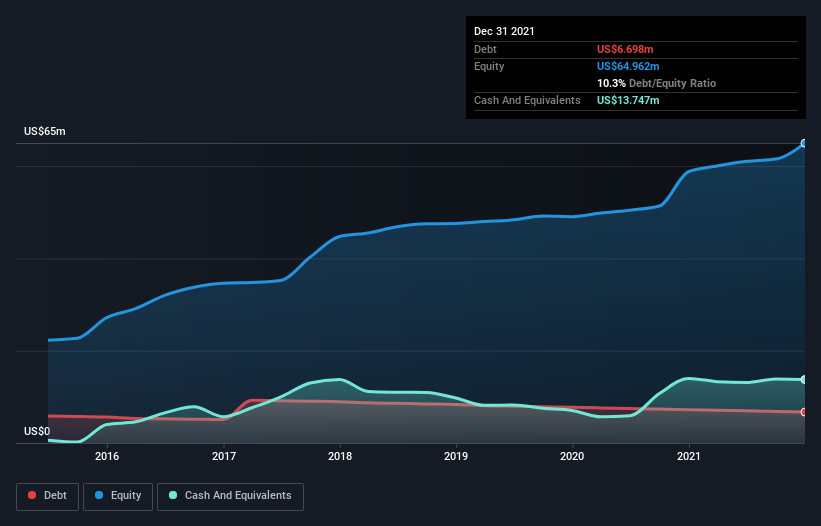- United States
- /
- Beverage
- /
- NasdaqCM:WVVI
Is Willamette Valley Vineyards (NASDAQ:WVVI) Using Too Much Debt?

Legendary fund manager Li Lu (who Charlie Munger backed) once said, 'The biggest investment risk is not the volatility of prices, but whether you will suffer a permanent loss of capital.' So it might be obvious that you need to consider debt, when you think about how risky any given stock is, because too much debt can sink a company. As with many other companies Willamette Valley Vineyards, Inc. (NASDAQ:WVVI) makes use of debt. But the more important question is: how much risk is that debt creating?
What Risk Does Debt Bring?
Debt assists a business until the business has trouble paying it off, either with new capital or with free cash flow. In the worst case scenario, a company can go bankrupt if it cannot pay its creditors. While that is not too common, we often do see indebted companies permanently diluting shareholders because lenders force them to raise capital at a distressed price. Of course, debt can be an important tool in businesses, particularly capital heavy businesses. The first step when considering a company's debt levels is to consider its cash and debt together.
View our latest analysis for Willamette Valley Vineyards
What Is Willamette Valley Vineyards's Debt?
The image below, which you can click on for greater detail, shows that Willamette Valley Vineyards had debt of US$6.70m at the end of December 2021, a reduction from US$7.22m over a year. However, its balance sheet shows it holds US$13.7m in cash, so it actually has US$7.05m net cash.

How Strong Is Willamette Valley Vineyards' Balance Sheet?
According to the last reported balance sheet, Willamette Valley Vineyards had liabilities of US$11.9m due within 12 months, and liabilities of US$14.5m due beyond 12 months. Offsetting these obligations, it had cash of US$13.7m as well as receivables valued at US$3.30m due within 12 months. So it has liabilities totalling US$9.36m more than its cash and near-term receivables, combined.
This deficit isn't so bad because Willamette Valley Vineyards is worth US$33.8m, and thus could probably raise enough capital to shore up its balance sheet, if the need arose. But it's clear that we should definitely closely examine whether it can manage its debt without dilution. While it does have liabilities worth noting, Willamette Valley Vineyards also has more cash than debt, so we're pretty confident it can manage its debt safely.
The modesty of its debt load may become crucial for Willamette Valley Vineyards if management cannot prevent a repeat of the 26% cut to EBIT over the last year. When a company sees its earnings tank, it can sometimes find its relationships with its lenders turn sour. When analysing debt levels, the balance sheet is the obvious place to start. But you can't view debt in total isolation; since Willamette Valley Vineyards will need earnings to service that debt. So when considering debt, it's definitely worth looking at the earnings trend. Click here for an interactive snapshot.
But our final consideration is also important, because a company cannot pay debt with paper profits; it needs cold hard cash. While Willamette Valley Vineyards has net cash on its balance sheet, it's still worth taking a look at its ability to convert earnings before interest and tax (EBIT) to free cash flow, to help us understand how quickly it is building (or eroding) that cash balance. Over the last three years, Willamette Valley Vineyards saw substantial negative free cash flow, in total. While that may be a result of expenditure for growth, it does make the debt far more risky.
Summing up
Although Willamette Valley Vineyards's balance sheet isn't particularly strong, due to the total liabilities, it is clearly positive to see that it has net cash of US$7.05m. Despite the cash, we do find Willamette Valley Vineyards's EBIT growth rate concerning, so we're not particularly comfortable with the stock. There's no doubt that we learn most about debt from the balance sheet. But ultimately, every company can contain risks that exist outside of the balance sheet. We've identified 4 warning signs with Willamette Valley Vineyards (at least 1 which is significant) , and understanding them should be part of your investment process.
When all is said and done, sometimes its easier to focus on companies that don't even need debt. Readers can access a list of growth stocks with zero net debt 100% free, right now.
Valuation is complex, but we're here to simplify it.
Discover if Willamette Valley Vineyards might be undervalued or overvalued with our detailed analysis, featuring fair value estimates, potential risks, dividends, insider trades, and its financial condition.
Access Free AnalysisHave feedback on this article? Concerned about the content? Get in touch with us directly. Alternatively, email editorial-team (at) simplywallst.com.
This article by Simply Wall St is general in nature. We provide commentary based on historical data and analyst forecasts only using an unbiased methodology and our articles are not intended to be financial advice. It does not constitute a recommendation to buy or sell any stock, and does not take account of your objectives, or your financial situation. We aim to bring you long-term focused analysis driven by fundamental data. Note that our analysis may not factor in the latest price-sensitive company announcements or qualitative material. Simply Wall St has no position in any stocks mentioned.
About NasdaqCM:WVVI
Willamette Valley Vineyards
Produces and sells wine in the United States and internationally.
Mediocre balance sheet and slightly overvalued.


